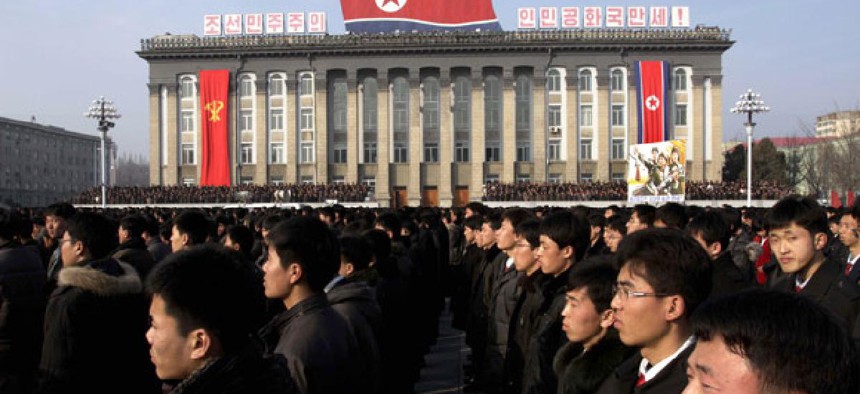Possible North Korea Nuke Test Emissions Identified

Jon Chol Jin/AP
International group says it identified radioactive materials released months ago.
An international nuclear nonproliferation organization said on Tuesday it has identified what appear to be radioactive materials released more than two months ago by North Korea’s third nuclear test.
Sensors in Japan and Russia detected the xenon 131m and xenon 133 earlier this month, according to the Preparatory Commission for the Comprehensive Test Ban Treaty Organization.
“The ratio of the detected xenon isotopes is consistent with a nuclear fission event occurring more than 50 days before the detection (nuclear fission can occur in both nuclear explosions and nuclear energy production),” the Vienna, Austria-based body said in a press release. “This coincides very well with announced nuclear test by the D.P.R.K. that occurred on 12 February 2013, 55 days before the measurement.”
There has been little question that North Korea detonated a nuclear device within an underground chamber at its Punggye-ri installation. State media declared the event, which was instantaneously detected by 94 CTBT seismic sensor sites and two infrasound stations.
Detection of radioactive material was seen as offering definitive proof of the blast. Issue experts had theorized that the absence of such a find suggested the North intentionally sealed the test chamber to prevent material escapes.
The North has now been determined to be a probable origin site for the radioactive noble gases via atmospheric modeling of how weather patterns would move the material, the agency noted.
It said, though, that the conclusion provided no assistance in determining whether Pyongyang detonated a plutonium-based device as in its 2006 and 2009 tests, or if instead it used highly enriched uranium for the first time.
“To be able to distinguish between uranium and plutonium, it helps if a detection is made early (before the decay of isotopes) and the amount of registered radioactivity is large,” according to a CTBTO fact sheet.
"At this stage it is very unlikely that remote sensing is going to provide any clues as to what material the test involved," said Daryl Kimball, executive director of the Washington-based Arms Control Association.
Definitive word would probably have to come from North Korea, added Jeffrey Lewis, director of the East Asia Nonproliferation Program at the James Martin Center for Nonproliferation Studies. "Either they tell us, or ... a little bird overhears them talking about it," he stated by e-mail.
The preparatory commission is charged with fielding and operating hundreds of detection facilities that would use four different sensor technologies to catch breaches of the Comprehensive Test Ban Treaty, which has yet to enter into force.
North Korea has not joined the pact and continues to push ahead with its nuclear arms program in the face of overwhelming global opposition. It is the only nation in the last 15 years to conduct explosive atomic trials.
"The latest detection shows again that the CTBT verification regime is very sophisticated and stands ready to provide confidence to states that no nuclear explosion will escape detection," CTBTO spokeswoman Annika Thunborg stated by e-mail.
Thunborg in March said CTBTO officials did not expect to find any radioactive remnants one month after the test.
“Detection of radioactive noble gas more than seven weeks after the event is indeed unusual, we did not expect this and it did not happen” in North Korea’s previous nuclear test more than three years ago, according to the Tuesday CTBTO statement.
Primary detection of xenon occurred on April 8 and 9 in Takasaki, Japan, 620 miles from Punggye-ri, followed by a lower-level identification from April 12 to 14 at Ussuriysk, Russia. Further analysis was necessary before the findings could be announced, the organization said.
Findings suggest an “instantaneous” emission of 1 to 10 percent of the noble gases that would have been left from February, the agency said. It declined to speculate on the cause of the release.
"Sometimes the geology of the test site means that the radiological gases that are produced to not escape to the surface for some time," Kimball said in a telephone interview.
It remains possible that the materials did not originate in North Korea, the treaty organization acknowledged. However, it ruled out Japan’s earthquake-crippled Fukushima Daiichi nuclear plant as the source and played down the potential for spoofs.
While it would be feasible for the North to release the radioactive gases without setting off a nuclear device, producing the 4.9-magnitude earthquake that occurred on Feb. 12 with standard explosives would be “technically very challenging” and hard to pull off without being caught, the agency said.
NEXT STORY: GAO raps DOD satellite operations





